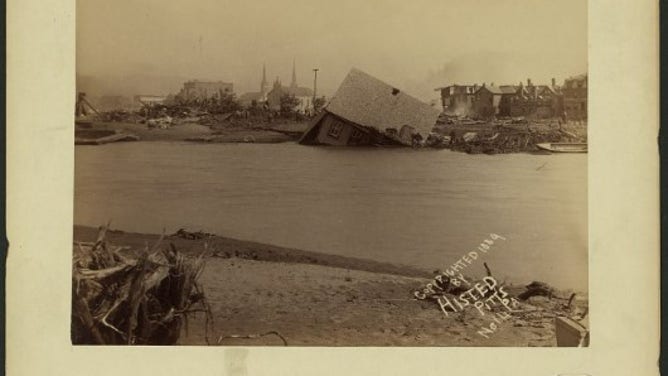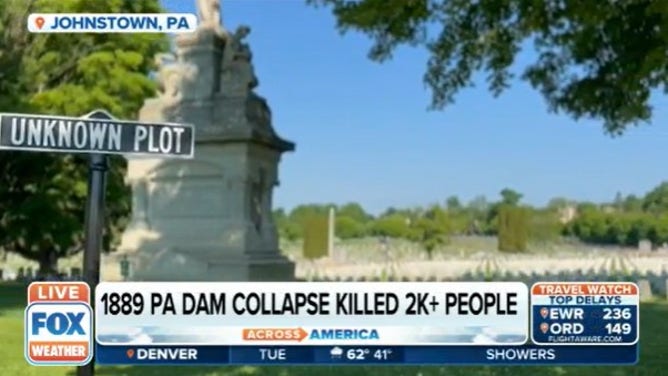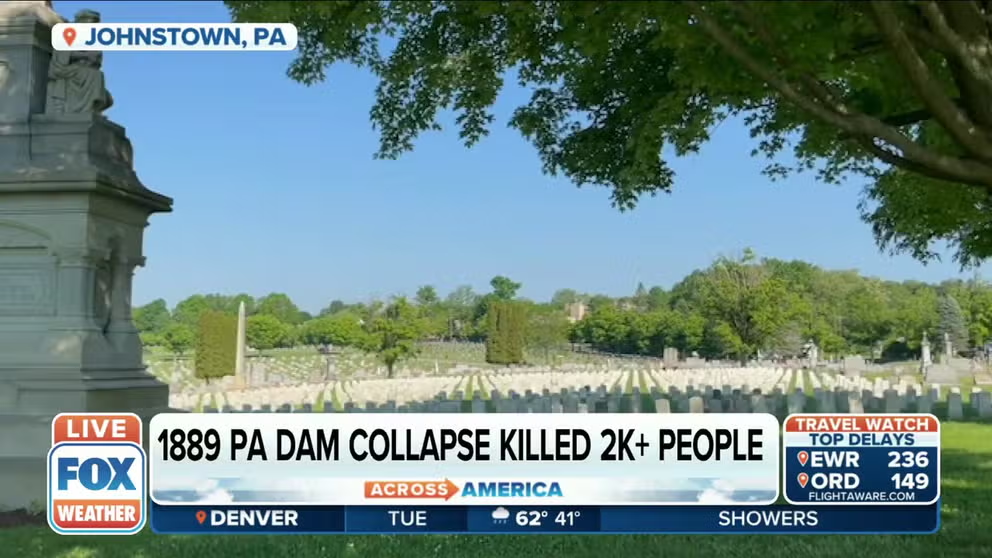Johnstown Flood of 1889: How the deaths of 2,209 people changed American attitudes
The flood that occurred 133 years ago killed 2,209 people went ‘well beyond the incredible loss of life’ and started a shift in the way Americans think of ‘liability and fault’ for natural disasters.
133 Years ago the Johnstown Flood killed more than 2,000 people
FOX Weather's Katie Byrne visits Johnstown, Pennsylvania where in 1889, a dam collapsed sending a 40-foot wall of water barreling through town.
JOHNSTOWN, Pa. – More than 2,000 people were killed when a wall of water, 40-feet high, barreled through Johnstown, Pennsylvania 133 years ago.
The flood that occurred on May 31, 1889, is considered one of the deadliest floods in U.S. history.
Each year, residents of the town remember the lives lost and reflect on the start of a shift in thinking about natural disasters.
"[Eyewitnesses] described it as looking like the hillside moved, that it didn't look like water," Shelley Johansson, Director of Communications for the Johnstown Area Heritage Association told FOX Weather. "A lot of people assumed that it was the end of the world, which was probably a pretty reasonable assumption when you hear the description of the towering mass of debris that came thundering down towards the valley."
7 FACTS YOU SHOULD KNOW ABOUT FLASH FLOODS
Homes, railroad cars and even livestock all crashed into the stone bridge and piled up to the top of the arches. Debris spread across 30 acres.

The stone bridge (only a few years old at the time) caught storm debris which piled up to the arches.
(FOX Weather)
The area experienced flooding rains. Almost 10 inches fell across the area in the 24 hours before the South Fork Dam collapsed. Hydrologic modeling, just in the last decade, proved that poor maintenance on the earthen dam resulted in its failure.
"The flood was an accident waiting to happen, it was really predictable," said Richard Burkert, President and CEO of the Johnstown Flood Museum.
The exclusive South Fork Hunting and Fishing Club owned the dam that created a large upstream reservoir.

Homes were carried down river and the furniture, kids toys and clothes littered the banks.
(Photographer Ernest Walter Histed, c1889; Library of Congress LOT 2564, no. 14)
"The South Fork Fishing and Hunting Club was owned by all of the wealthy industrialists of Pittsburgh and names that we know like Carnegie and Mellon and everybody that was anybody," said Johansson of Johnstown being a summer getaway.
News correspondents flocked to Johnstown from across the U.S. The story covered the front page of the New York Times for nine days, according to Burkert.
"And after the flood, it was sort of the first really major anger towards the robber barons of the period," continued Johansson. "This was the ruling class of the United States at that time, and to express anger towards them was really rather unthinkable."
WHAT DOES THE TERM ‘100-YEAR FLOOD’ ACTUALLY MEAN?
Andrew Mellon would become the U.S. Treasury Secretary and Andrew Carnegie was one of the richest men in America.
"And so it was sort of a shift in the way people thought about that kind of thing and liability and fault and things of that nature," Johansson said. "It's one of the things reasons why the flood is such an important event in American history well beyond the incredible loss of life."
HOW HEAVY IS IT REALLY GOING TO RAIN?
A section of the Grandview Cemetery marks graves of unknowns – blank stones above bodies that were never identified.

The "Unknown Plot" of the Grandview Cemetery is the final resting place for victims of the flood that were never identified.
(FOX Weather)
"My great-great grandfather, he and his wife and five children and one brother survived the flood, but he and his brother lost everyone else in their family," said Dave Casker, tour guide at the Johnstown Flood Museum, of his 16 relatives living at the time in Johnstown. "Eight of them survived and eight of them died. The bodies of four could not be identified after the flood. And so they are on the Unknown List."
A century later, residents are still finding artifacts from this disaster that wiped out almost 10% of the population. In memory, the National Park Service built the Johnstown Flood National Memorial. Curators have plans to add the recent finds.
Another change for American history was marked by the Red Cross’ role. This was the Red Cross’ first major disaster relief effort.
CLICK HERE TO GET THE FOX WEATHER UPDATE PODCAST
The Pennsylvania Rail Road and telegraph lines washed away in the flood, so the agency didn’t arrive until June 5th.
"At that point, it had been a battlefield relief organization only, from the Civil War… There were actually competing Red Cross chapters," said Johansson. "The American Red Cross got here, and they focused primarily on material relief, on the survivors, getting people housed and getting them enough material goods that they could kind of get a foothold on life again."
EXPLAINING FLOOD ALERTS ISSUED BY NATIONAL WEATHER SERVICE
Founder, Clara Barton at 67 led the effort in Johnstown after re-imagining the group’s purpose.
"The idea was to memorialize the dead by coming back stronger than ever. And at that time, Johnstown was a technological innovator in steel," said Burkert of the town rebuilding after the flood. "The town exploded population-wise. Lots of immigrants came here looking for work. It was a remarkable recovery and I think a real testament to the resilience of the people here."
